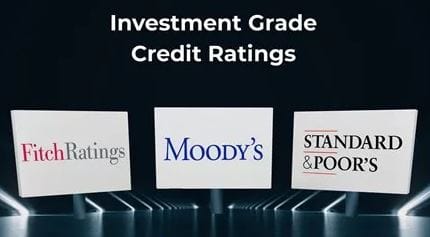Credit Ratings
Credit rating agencies play a crucial role in global finance by assessing the creditworthiness of issuers of debt, including governments, corporations, and financial institutions. The three dominant players in this space are Moody's Investors Service, Standard & Poor's (S&P), and Fitch Ratings

On May 16, 2025, Moody's Investors Service downgraded the United States' long-term credit rating from Aaa to Aa1, marking the first time all three major credit rating agencies have rated U.S. sovereign debt below their top tier.
Reasons for the Downgrade
Moody's cited several factors for the downgrade:
- Persistent Fiscal Deficits: The U.S. has consistently run large annual deficits without implementing measures to reverse this trend.
- Rising Interest Costs: Growing federal interest payments, driven by higher interest rates, have increased the cost of financing the national debt.
- Tax Policy Implications: The potential extension of the 2017 Tax Cuts and Jobs Act provisions could add approximately $4 trillion to the national debt over the next decade.
- Political Gridlock: Successive administrations and Congress have failed to agree on measures to address fiscal challenges, leading to concerns about the effectiveness of U.S. policymaking.
Economic Implications
The downgrade has several potential consequences:
- Increased Borrowing Costs: Investors may demand higher yields on U.S. Treasury securities, leading to increased borrowing costs for the government.
- Market Volatility: The downgrade contributed to a sell-off in government bonds and a rise in Treasury yields, with the 30-year yield surpassing 5%.
- Impact on Government-Sponsored Enterprises: Following the sovereign downgrade, Moody's also downgraded Fannie Mae and Freddie Mac, reflecting their reliance on federal support.
Outlook
Moody's revised the U.S. credit outlook from negative to stable, indicating no immediate expectation of further downgrades.
This downgrade underscores the importance of addressing fiscal challenges to maintain economic stability and investor confidence.
Credit rating agencies play a crucial role in global finance by assessing the creditworthiness of issuers of debt, including governments, corporations, and financial institutions. The three dominant players in this space are Moody's Investors Service, Standard & Poor's (S&P), and Fitch Ratings. Collectively known as the "Big Three," these agencies influence global capital markets by providing investors with ratings that gauge the risk of default. This article provides a comprehensive overview of their origins, rating methodologies, and key downgrades over the past 25 years.
Origins of the Big Three
1. Moody's Investors Service
- Founded: 1909 by John Moody.
- Purpose: Initially aimed to provide reliable bond ratings to investors.
- Current Role: Moody's offers credit ratings, research, and risk analysis on a global scale. It remains one of the most influential voices in the credit world.
2. Standard & Poor's (S&P)
- Founded: 1860 by Henry Varnum Poor.
- Evolution: Merged with Standard Statistics in 1941 to become S&P.
- Current Role: In addition to providing credit ratings, S&P is known for its financial indices, including the S&P 500.
3. Fitch Ratings
- Founded: 1913 by John Knowles Fitch.
- Ownership: Currently owned by the Hearst Corporation.
- Current Role: Fitch provides credit ratings and financial analysis across various sectors.
Methodologies and Rating Criteria
Each agency has a slightly different process for determining credit ratings, but all share a commitment to thorough analysis and committee-based decision-making.
Moody's Methodology
- Quantitative Analysis: Financial ratios, debt levels, cash flow.
- Qualitative Assessment: Industry outlook, competitive position, and management quality.
- Baseline Credit Assessment (BCA): A stand-alone measure of credit risk without external support.
- Committee Review: Final rating decisions are made by a committee.
S&P Methodology
- Business Risk Profile: Industry risk, competitive position, and operational effectiveness.
- Financial Risk Profile: Cash flow, leverage, and profitability.
- External Factors: Government support or systemic importance.
- Committee-Based Decision: Ratings are finalized through a vote.
Fitch Methodology
- Initial Review: Can be initiated by request or unsolicited.
- Data Gathering: In-depth analysis of public and private financial data.
- Management Interaction: Meetings and interviews with company executives.
- Peer Comparison: Benchmarking against industry peers.
- Committee Vote: Ratings are determined by consensus.
Rating Scales
Moody’s Rating Scale
- Investment Grade: Aaa, Aa, A, Baa
- Speculative Grade: Ba, B, Caa, Ca, C
S&P and Fitch Rating Scales
- Investment Grade: AAA, AA, A, BBB
- Speculative Grade: BB, B, CCC, CC, C, D (Default)
Major Downgrades in the Last 25 Years
United States
- 2011: S&P downgraded the U.S. from AAA to AA+ due to political gridlock and rising debt.
- 2023: Fitch downgraded the U.S. to AA+ citing fiscal deterioration and governance concerns.
- 2025: Moody's followed with a downgrade to Aa1 over federal debt and policy uncertainty.
European Sovereign Debt Crisis (2010-2012)
- Multiple countries including Greece, Portugal, Ireland, and Spain were downgraded to junk status.
- Caused widespread market volatility and increased borrowing costs.
Venezuela (2013-2017)
- Downgraded to near-default by all three agencies amid hyperinflation and economic collapse.
China’s Evergrande Group (2021)
- Multiple downgrades by all three agencies as the property developer struggled with liquidity and default risk.
Russia and Ukraine (2022)
- Downgrades followed geopolitical instability and sanctions related to the Russia-Ukraine conflict.
The Big Three credit rating agencies—Moody’s, S&P, and Fitch—are integral to the modern financial system. Their ratings influence everything from interest rates to investment decisions. While their methodologies differ slightly, all aim to provide objective assessments of credit risk. Over the past quarter-century, these agencies have had to navigate numerous financial crises, making high-profile downgrades that shaped market behavior worldwide.
Understanding their processes and historical actions is essential for anyone involved in finance, from retail investors to policymakers.











